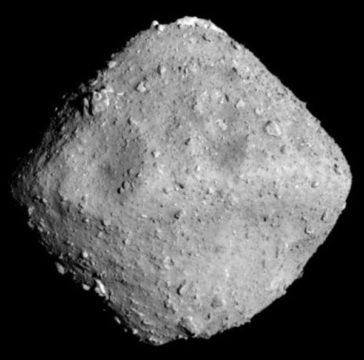Ryugu May Have Skirted Close to the Sun – Sky & Telescope


JAXA / University of Tokyo and collaborators
A combination of craters and surface color suggests that the near-Earth asteroid 162173 Ryugu was cooked by the Sun between a few hundred thousand and several million years ago — and that the asteroid might be remarkably younger than previously predicted.
The Japanese spacecraft Hayabusa 2 accompanied Ryugu around the Sun for nearly 17 months, observing it with cameras, dropping rovers, and touching down twice to pick up samples of surface rubble. The craft’s observations revealed a die-shaped world strewn with countless boulders that are surprisingly dehydrated, as I describe in our May 2020 issue.
As Hayabusa 2 now wends its way home, mission scientists are working to interpret what the craft saw on the kilometer-size asteroid. These assorted observations enabled scientists to study the asteroid in detail, even down to how the surface reacted when blasted with the spacecraft’s hydrazine thrusters.
JAXA / U. Tokyo / Kochi U. / Rikkyo U. / Nagoya U. / Chiba Inst. Tech. / Meiji U. / U. Aizu / AIST
The combined data show an oddly striated world. Ryugu’s equator and poles are tinged blue and are brighter compared with its darker, reddish mid-latitudes. These color differences wouldn’t be obvious to the human eye, although the brightness changes might be. Broken surfaces and boulder edges often look bluer; ragged, older surfaces look redder. During Hayabusa 2’s first touchdown, it also kicked up a cloud of dark, fine reddish grains and scattered boulders, including one the team dubbed Turtle Rock that seemed to be sandblasted bright by the exhaust.
As Tomokatsu Morota (University of Tokyo) and colleagues write in the May 8th Science, Ryugu’s boulders likely start bluish. Then a combination of solar wind exposure, meteoroid impacts, and solar heating reddens them. This redder stuff migrates to the asteroid’s mid-latitudes over time, because topographically those are the lowest on Ryugu’s surface. That movement leaves the higher equator and polar regions relatively bluer and brighter.
Just How Long Ago Were Ryugu’s Rocks Reddened?
Surface reddening is no surprise; planetary scientists have seen it on other kinds of asteroids. And although meteorite experiments a few years ago had suggested C-class asteroids like Ryugu would become bluer due to space weathering, recent follow-up experiments indicate that porous, dehydrated surfaces like Ryugu’s might indeed redden with time.
But the reddening reaches too deep into the surface to be due to normal space weathering, the authors argue. Red ejecta dug up by impacts streak the surface, and some small craters are actually redder than their surroundings, suggesting the red stuff is as least a few meters deep.
Furthermore, craters on Ryugu seem to fall into one of two groups, the team found: red or blue. There’s no gradual change. The dichotomy suggests that the reddening was an event, not a continuous process, and it happened before the blue craters were created.
Putting these data together, Morota and colleagues argue that Ryugu ventured too close to the Sun and was baked.
To pinpoint when this heating might have happened, the researchers looked at the red and blue craters’ sizes. Based on the number of craters of different sizes, they estimate that Ryugu went on its solar “excursion” between 300,000 and 8 million years ago, depending on whether it took the punches that made the craters in the region around Earth or in the main belt, before it came to the inner solar system. They also estimate that the heating happened some 8.5 million years after the asteroid’s formation. That would make Ryugu at most about 17 million years old.
This age is surprisingly young. Based on Ryugu’s orbit, scientists thought the little world was built from the debris of an asteroid smashup that happened in the main belt roughly a billion years ago — perhaps the same one that created Bennu, the target of NASA’s ongoing Osiris-Rex mission. Maybe multiple generations of asteroids formed and broke up before Ryugu coalesced, the authors suggest.
But the age estimates are far from certain, cautions Osiris-Rex scientist Daniella DellaGiustina (University of Arizona), who heads up that mission’s image processing. It’s still possible that space weathering, pulverization, and even carbon could redden the rocks, she explains. Also, scientists don’t know whether asteroids of this size and porosity react to large crater-making impacts the same way other bodies do.
Hayabusa 2 scientists take confidence from the shape of the crater blasted into Ryugu by their Small Carry-on Impactor (SCI), a 30-cm-wide copper disk mangled into a bullet and shot at the asteroid. But that was a relatively small hit, she says.
Study coauthor Seiji Sugita (University of Tokyo) acknowledges they’re taking a risk with their age prediction. But “we felt that this is a one-of-a-kind opportunity to predict and test,” he says. Researchers will be able to confirm Ryugu’s surface age once they test Hayabusa 2’s samples, which will drop in Australia this December. There’s more to be gained by going out on a limb and making a bold prediction, he says. “This is the best way to examine how well we understand nature.”
One final note: the proposed heating event couldn’t explain why Ryugu’s minerals show so little evidence of interacting with water, the Hayabusa 2 scientists write. The bluish, brighter regions are just as dehydrated as the reddish ones.
References:
T. Morota et al. “Sample Collection from Asteroid (162173) Ryugu by Hayabusa2: Implications for Surface Evolution.” Science. May 8, 2020.

